Analysis and Epoxy Asphalt
Structural Analysis of Asphalt Pavement
on Steel Plate deck and Epoxy Asphalt Mixture
Dr. Nakanishi Hiromitsu, Director, Global team, Taiyu
Prof. Tran Thi Kim Dang, UTC
Dr. Nguyen Quang Phuc, UTC
Mr. Kato Akihiro, Vietnam Office, Taiyu
ABSTRACT: This report is concerning to asphalt pavement on steel plate deck. Now, steel plate
deck bridge is increasing along with economic development of the country. However, some kinds of severe deterioration, rutting, longitudinal cracking, slippage from steel plate deck and others, are arising in this pavement. At present, there are two steel plate deck in Vietnam, Thang Long bridge
in Hanoi and Thuan Phuoc bridge in Danang. Longitudinal cracking and slippage from steel plate deck are arising on Thang Long bridge while slippage from steel plate deck seems to occur on Thuan Phuoc bridge. Such deterioration is the representative characteristics as the damage of the asphalt pavement on steel plate deck. However, so far, there have been no answers to the question about why such deterioration would arise in the pavement on steel plate deck. In this report, at first, a structural model is proposed as a simulation method to calculate stress, strain,
and shear stress which would generate in asphalt pavement on a steel plate deck. Secondly, epoxy
asphalt mixture and epoxy type tack coat material are introduced as the suitable materials to endure the stress and strain which would be generated in the pavement on steel plate deck.
1. INTRODUCTION
Asphalt pavement on steel plate deck has been subjected to various deterioration, longitudinal cracking, slippage from the steel plate deck, rutting, stripping, blistering, and others, as shown in photographs. These problems are deeply concerning to the structure of pavement on steel plate deck.

However, there were no research reports on the structural design for the pavement on steel plate deck. Longitudinal cracking must be influenced by longitudinal ribs just below steel plate and slippage should be related to the shear stress arising between steel plate and pavement. In spite of that, there have never been methods to simulate about how large strain or stress would work in the pavement on steel plate deck. As a result, we didn’t know what kinds of property of the asphalt mixture would be able to lead to the long term durability of the pavement on steel plate deck.
2. ON-SITE STRAIN INVESTIGATION
MIKAWA Port Bridge which has steel plate deck with the length of 300m has been constructed in Japan in 1979, and epoxy asphalt mixture has been adopted as a pavement material. Furthermore, epoxy resin has been used as a tack coat. In fact, this bridge has been opened to the general traffic in 1982. We have carried out some investigations on site, like a strain measurement by loading a dump truck, before being opened to general traffic. And, I‘d like to add that this pavement has been available with no maintenance for this 35 years although some cracking have arisen.
2.1. Wheel load
The data of the dump truck used for the on-site investigation are as shown in Table 2.1.

2.2. Location of strain measurement
The location of strain gauges and loading positions were set as shown in Fig. 2.1 and Fig. 2.2. Further detail information would be obtained in reference [1]
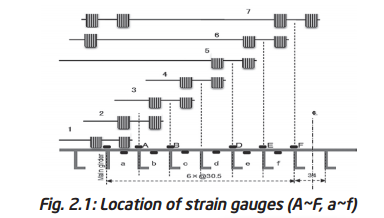

3. COMPOSITE BEAM CONSISTING OF SURFACE
COURSE, BINDER COURSE, AND STEEL PLATE DECK
The calculation shall be based on “Euler’s Assumption” that the plane cross section shall incline with keeping plane after receiving bending force. The cross section model of the three layers structure is as shown in Fig. 3.1
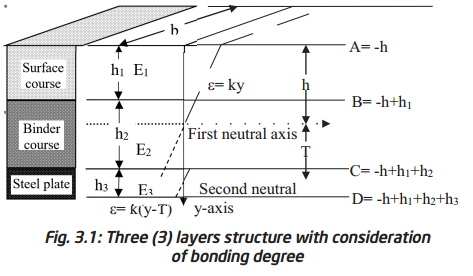
Here, it is assumed that the interface between surface layer and binder layer is perfectly bonded and the interface between the binder layer and the steel plate is un-perfectly bonded. Regarding the degree of bonding, the bonding coefficient “t” from 0 to 1,0 is defined, the bonding coefficient “t” of 1,0 provides the perfect bonding while the bonding coefficient “t” of 0 provides the perfect non-bonding. Furthermore, in case of perfect un-bonding, the two (2) neutral axes must generate at the position of the neutral axis of the composite layer of surface layer and binder layer and the neutral axis of the steel plate, respectively. The distributions of strain around two (2) neutral axes must be based on “Euler’s Assumption” and the slopes of the distributions must be same. The position of the neutral axis of the composite layer of the surface layer and the binder layer is h0 from the top of surface and h0 can be derived by Equation (1).

The neutral axis of the steel plate generates at the position of (h3/2). If the distance between two (2) neutral axes would be (T), (T) can be expressed as follows using the bonding coefficient, (t)
![]()
If the formula of the strain occurring around the first axis is expressed by ε = ky and the position of the origin is y = 0, the formula of the strain occurring around the second axis can be expressed by ε = k(y – T). The equation of equilibrium of the fiber stress at the situation can be shown as follows;
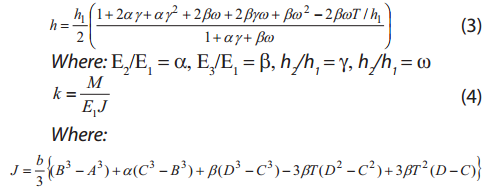
3.1. Distribution of strain and stress occurring in
three layers composite beam
The strain and stress occurring in the three (3) layers composite beam can be shown as follows using the moment of inertia area, (J). (The position of the neutral axis is coordinate origin).
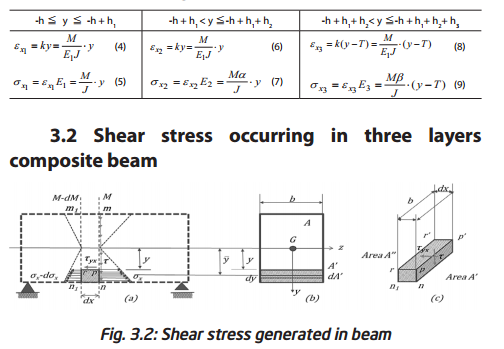
Shear stress occurring in three (3) layers composite beam need to be considered. In general, the shear stress can be obtained using the following formula.
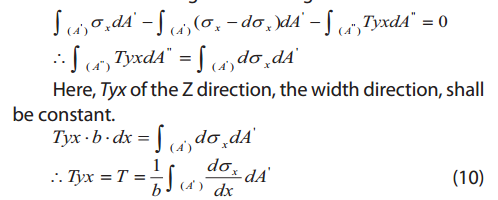
Regarding the detail of expansion of equations, there is precise explanation in reference [1]. Here, the final equations are shown.
(In case of surface course, -h ≦ y ≦ -h + h1)


4. PROPOSAL OF STRUCTURAL MODEL FOR
PAVEMENT ON STEEL PLATE DECK
4.1. Behavior of Pavement on Steel Plate Deck
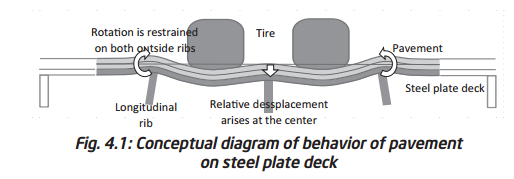
Behavior of the pavement on steel plate deck is thought as shown in Fig. 4.1. The supports on the ribs at both sides of tire is not fully fixed but the rotation would be restrained in proportion to the deflection slope. And, regarding the support between double tires, the relative displacement would arise.
4.2. Beam Model for Pavement on Steel Plate Deck.
If considering the behavior mentioned above, structural model is simplified as shown in Fig. 4.2. The characteristics of this Model are to have an elastic hinge at support A and to have an elastic support at support B. Therefore, the vertical direction movement in proportion to the reaction at support B would be allowed with this Model in addition that the free rotation at support A is restrained by the elastic hinge. The adoption of the elastic support at B support would result in lowering the whole rigidity of this structure.
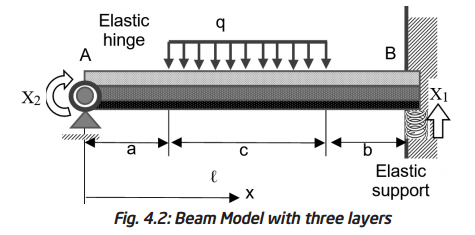
This Model is secondary statistically indeterminate beam. There are some calculation approaches, the structural calculation carried out here is based on Principle of virtual work. [2] Bending moments at each condition are shown in Table 4.1. Here, the influences by normal axial force and shear force which would be subjected to the beam are ignored.
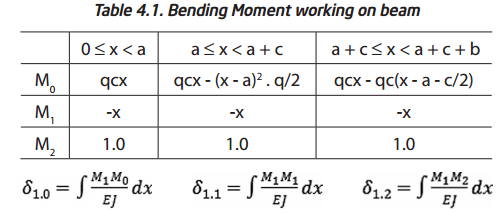
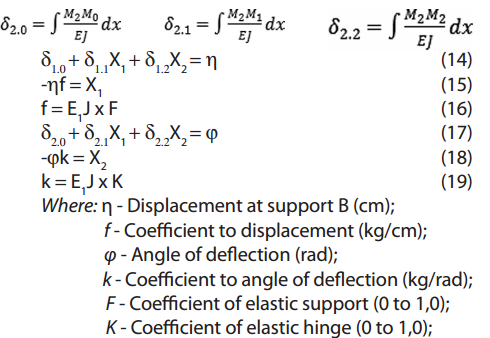
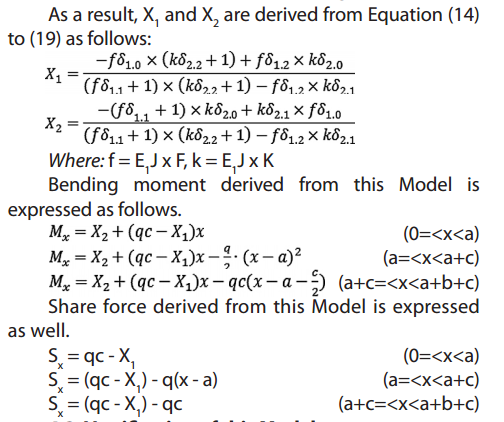
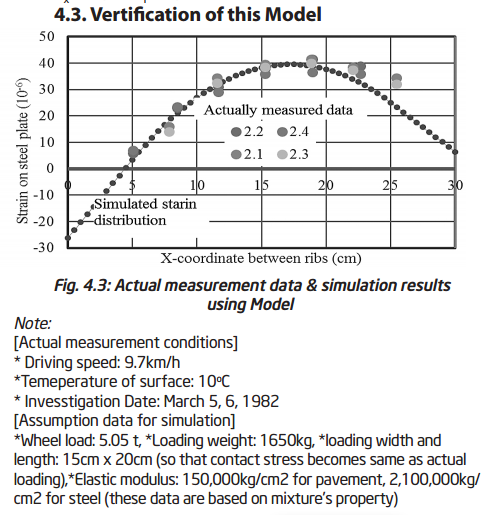
Strains on the undersurface of steel plate, which have been measured on March, 1982, and calculated strains are shown in Fig. 4.3. In fact, coefficient, k and f, are set so that the simulation curve could meet with actually measured data. As aresult, k, f, and relevant φ and η are a shown in Table 4.2.

On the same conditions as shown in Fig. 4.3 and Table 4.2, the distribution of tensile strains on the surface of asphalt pavement and the distribution of shear stress which would work in the structure are shown in Fig. 4.4 and Fig. 4.5, respectively.
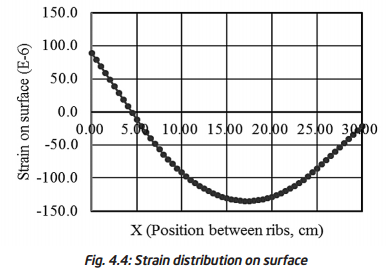

According to the simulation, in spite of cold season and relatively small wheel load of 5,05 tons, larger strain of about 100kg/cm2 works just above longitudinal rib. Furthermore, the shear stress as large as 11kg/cm2 is generating on the interface between pavement and steel plate. Regarding the coefficient of K and F, they represent the rigidity of the structure including pavement properties. If the thickness of the steel plate deck is thin or the temperature of the asphalt pavement is high, the
rigidity of the whole structure should become smaller. In my idea, K would be from 0,02 to 0,035 and F would be 0,0003 to 0,0006, but further research would be needed. However, the most important thing is that the strain which would generate on the pavement surface or the shear stress which would generate between steel plate deck would be able to be calculated if employing this Model.
5. PAVEMENT ON STEEL PLATE DECK &
MATERIALS TO BE USED ON THANH LONG BRIDGE
According to the information on Thanh Long Bridge in Hanoi, the thickness of steel plate deck is 1,4cm, the pavement has been paved by SMA using PMB 3 and the total thickness of two layers is 7cm. And, Bond Coat has been applied as a tack-coat between steel plate and pavement.


Based on the information about Thanh Long Bridge, we simulated the strain and the shear stress which would generate. Regarding the simulation, the calculation conditions will be set so as to meet actual situation in Thanh Long Bridge. The calculation results are shown in Fig. 5.1 and 5.2. Note: Simulation conditions are; Wheel road: 10 tons, Elastic modulus of SMA with PMB3: 10,000kg/cm2, Perfect bonding at interface
Simulation results show the maximum tensile strain above rib is about 1500*10-6. Furthermore, shear stress between steel plate deck and pavement is about 12kg/cm2. These simulation results would suggest that the pavement on Thanh Long Bridge is being suvjected to the severe stress and strain situation. Therefore, in order to prevent from various deteriolation like longitudinal cracking and slippage, the materials which would be able to endure such strain and stress situation should be employed on Thanh Long Bridge. In our experiences, only Epoxy asphalt mixture and Epoxy type tack-coat would be able to endure such severe conditions. We can not give you enough explanation due to the paper length limitation, we’d like you to refer to reference [3]. Here, only the data on fatigue characteristics of epoxy asphalt mixture is introduced in Fig. 5.3

Fig. 5.3 Fatigue test results for various asphalt mixture
As far as we look at Fig. 5.3, the fatigue life of Epoxy asphalt mixture is about 10 times longer than the conventional asphalt mixture. Furthermore, because the elastic modulus of the epoxy asphalt mixture is relatively higher than the conventional one, the strain generated should become smaller.

Photo. 5.1: Spray of Epoxy type tack-coat.
Regarding the shear stress generated at the interface between steel plate and pavement, if conventional tackcoat would be employed, slippage like on Thanh Long Bridge should arise because shear stress itself is very big. Against this problem, we would like to recommend Epoxy
type tack-coat because it exerts very strong bonding strength more than 28kg/cm2 [3].
Acknowledgement
We appreciate this conference secretariats for giving us an opportunity to present on the structural simulaion about the pavement on Steel Plate Deck, which has not been tackled so far.
References
[1]. H. Nakanishi (March 2016), Structural design
Method for the Pavement on Steel Plate Deck, UTC seminar.
[2]. For example, R. Arai (1968), Applied
Mechanics, Gihodo.
[3]. Taiyu Kensetsu Co., Ltd., TAF-EPOXY & TAF-MIX EP,
Technical brochure
Other posts
